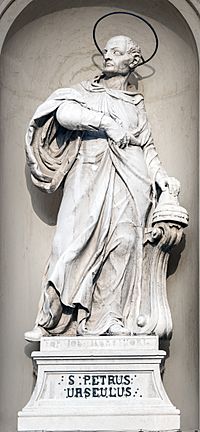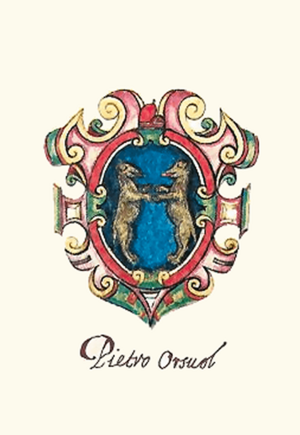Pietro I Orseolo facts for kids
Quick facts for kids St. Pietro Orseolo, OSBCam |
|
|---|---|

San Rocco, Venice
|
|
| Doge | |
| Born | 928 Udine, Republic of Venice |
| Died | 10 January 987 Cuxa, County of Conflent |
| Venerated in | Catholic Church |
| Beatified | 1027 by Arnulf |
| Canonized | 1731, Rome, Papal States, by Pope Clement XII |
| Major shrine | Prades, Pyrénées-Orientales, France |
| Feast | 10 January; 19 January (Camaldolese Hermits) |
Pietro I Orseolo (born 928, died 987) was an important leader of Venice. He was known as the Doge of Venice from 976 to 978. A Doge was like a duke or chief ruler of Venice.
Pietro surprised everyone by giving up his powerful job. He left Venice secretly to become a monk. He later joined a special group of monks called the Camaldolese Hermits. Today, he is honored as a saint in the Catholic Church.
Contents
Pietro's Early Life and Career
Pietro Orseolo was born in 928 near Udine, a city in Italy. His family was one of the most powerful in Venice. They were descendants of earlier Doges.
When he was just 20 years old, Pietro became the commander of Venice's navy. He was a brave and skilled soldier. He led successful battles against Dalmatian pirates who attacked Venetian ships.
Pietro was also a very religious person. He had a son named Pietro II Orseolo, who later became a Doge too. He also had a daughter who married into the important Morosini family.
Becoming the Doge of Venice
In 976, the Doge at the time, Pietro IV Candiano, was killed. This happened during a big protest against his rule. People were unhappy because he tried to make his position like a king's.
After this event, Pietro Orseolo was chosen to be the new Doge. He was married to Felicia Malipiero.
As Doge, Pietro was very good at bringing peace back to Venice. He was also kind to the previous Doge's widow. He showed great generosity to his people.
Helping the Community
Pietro used his own money to help rebuild Venice. Much of the city, including the Doge's Palace and the ducal chapel (now St. Mark's Basilica), had been destroyed. He also built hospitals and cared for people in need. This included widows, orphans, and travelers.
After two years as Doge, Pietro made a big decision. On September 1, 978, he left Venice without telling anyone, not even his family. He went to a monastery in southern France called Saint-Michel-de-Cuxa.
Life as a Monk and Hermit
At the monastery, Pietro lived a very simple and strict life. He did the most basic jobs. It seems he had thought about becoming a monk for a long time.
He only contacted Venice once to teach his grandson, Otto Orseolo, about living a good Christian life. Otto later became a Doge himself.
After some years as a monk, Pietro decided to live as a hermit. This meant living alone in the forest. He lived this way for seven years until he died. His body is buried in a church in Prades, France.
Honored as a Saint
Forty years after Pietro's death, in 1027, he was officially recognized as "blessed" by the local bishop.
The Catholic Church honors Pietro Orseolo as a saint. In 1731, Pope Clement XII officially made him a saint. His special day, or feast day, is celebrated on January 10. The Camaldolese monks celebrate his memory on January 19.
See also
- Saint Pietro I Orseolo, patron saint archive
 In Spanish: Pedro Orseolo para niños
In Spanish: Pedro Orseolo para niños


